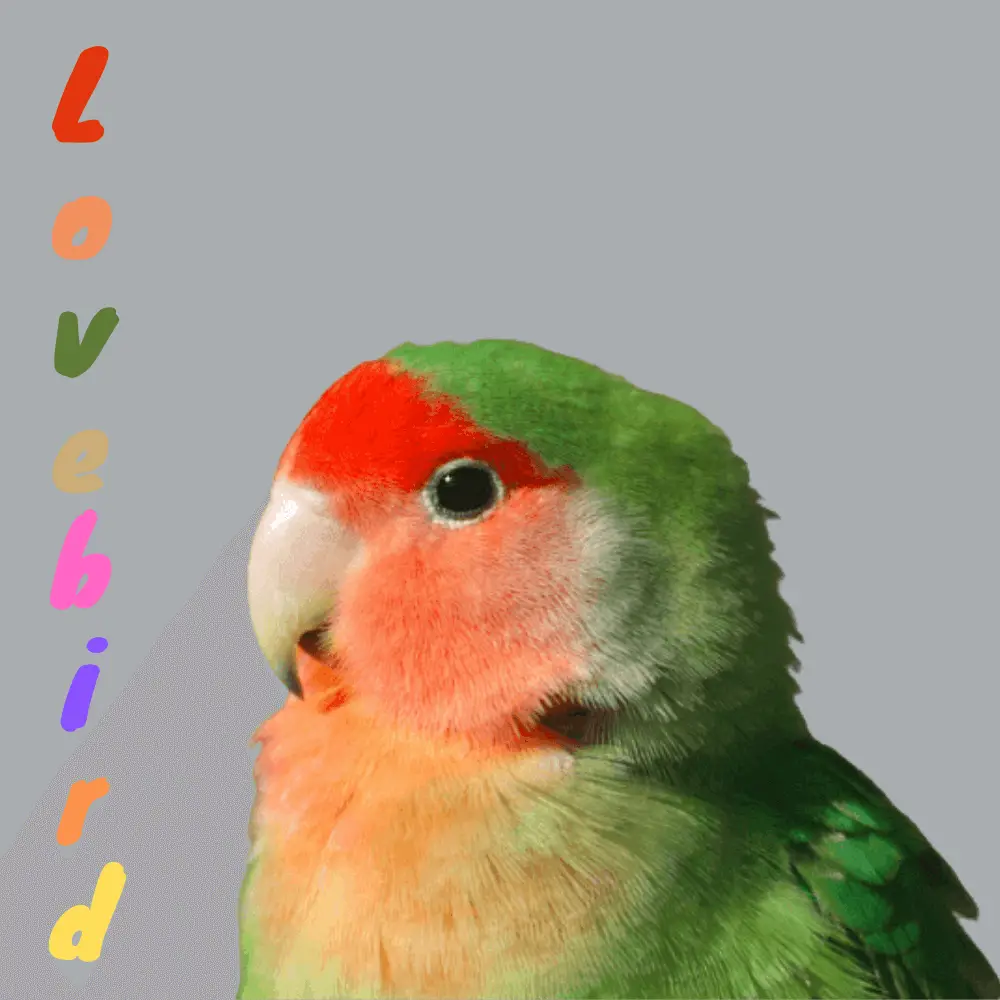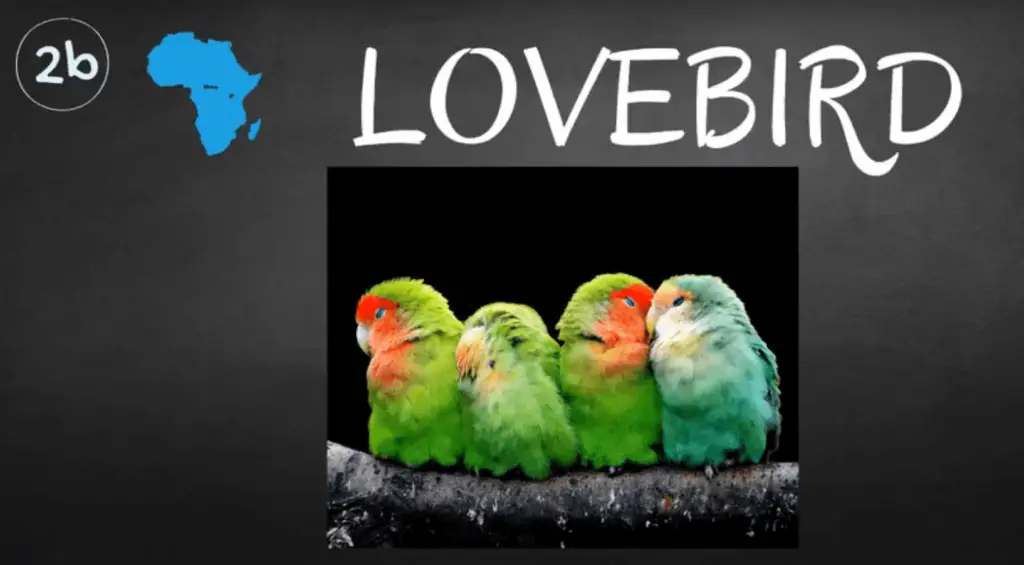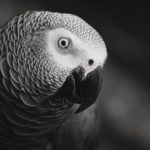
In an era when the parrot becomes more and more popular as a domestic companion, the little lovebird, by its size and price, is often seen as an ideal choice. In addition, no one can object to the fact that this little parrot is very flirtatious and is one of the most fun to watch. However, are you ready to make the necessary sacrifices to keep your little one happy?
I will first give you a description of this type of parrot, then I will try to describe its personality and give you a real insight into the demand necessary to live with such a bird.
If despite all the sacrifices that it takes, you are still able to love them and are willing to take care of them, this type of parrot may be for you.
Origin of the name
The English name for a lovebird is “lovebirds”. Anyone who has ever had the chance to see two lovebirds together will understand the origin of this name.
They were named so because of their habit of always sticking to each other. The Latin name for lovebird is Agapornis which derives from the Greek word “agape” which means “love” and from “ornis” which means “bird”.
Lovebird Description
Despite their small size ( between 12 and 18 cm ), lovebirds are members of the parrot family ( psittacidae ) in good standing as evidenced by their hooked beaks and the bites that can result.
They have a small round or square tail, unlike the parakeets which are distinguished by a long, thin tail. They weigh, on average, between 45 and 60 grams and have a life expectancy of around 12 years.
With the multiple mutations ( over 100,000 ) that we find in captivity, it is practically possible to have a lovebird of the color of our choice. The lovebird will soon be a new decorative element that will coordinate perfectly with the colors of our living room!
We find 9 different species of lovebirds, all native to the African continent, which we can classify into 3 categories.
Lovebirds as Pets | Living with Lovebirds | Species Spotlight
Sexual dimorphism
The sex of species in this category can be distinguished by their physical appearance.
- The Gray-headed Lovebird or more commonly known as the Madagascar Lovebird ( Agapornis Cana ) is quite rare in captivity due to export controls from Madagascar, its country of origin. The male is gray on the head, neck and chest. The female differs from the male by being completely green.
- The male Red-headed Lovebird ( Agapornis Pullaria ) is mostly light green to yellow with a reddish-orange head and beak. It is black at the shoulders and below the wings. The female has a more orange head than the male. The red-headed lovebird is the most common species on the African continent, its range extends from central Africa to Ethiopia. However, this species is extremely rare in captivity, because its mode of reproduction in thermal regions is difficult to imitate by breeders.
- The Abyssinian lovebird (Agapornis Taranta ), also known as the black-winged lovebird , is predominantly green. The male has the top of the head and a small circle of feathers surrounding his eyes that are red in color. The female has no red, neither on the head nor at the level of the eyes. We find this species of lovebird in altitude in the Ethiopian region. More popular than the previous two in captivity, it remains quite rare.
With eye ring

The species in this category all have the same physical trait in common, that is, a white featherless circle around the eyes and a red beak. Males and females in this category are indistinguishable by their physical appearance.
- The Fisher lovebird ( Agapornis fischeri ) is one of the most common species in captivity. This species was discovered by Dr. Fischer in 1817 in Tanzania. Fischer’s Lovebird is green, darker ( almost olive green ) on the wings and back, and paler on the breast. The top of its head is red, its cheeks and throat are an orange color.
- The Liliane Lovebird ( Agapornis Lilianae ) is relatively new in captivity and is the rarest of the eye circles. It was discovered in 1890 by Miss Lilian Sclater, hence the origin of its name. In the wild, we find it in Mozambique and Zambia. It is mostly green with a salmon-colored head tending to orange.
- We find the black-cheeked lovebird ( Agapornis Nigrigenis ) in Zambia, it is the species with the smallest range. It is green but much paler than Liliane’s lovebird. Its head is black, its throat is salmon-colored, its wings are dark green.
- The masked lovebird ( Agapornis personata ), very popular in captivity, has generally green plumage with smoky blackhead and cheeks. We find in this species a very beautiful blue mutation, where the original green is replaced by blue. It is easily distinguished from the others because it has a small yellow collar of about 1.5 cm. Its range, in the wild, is northeastern Tanzania to southeastern Kenya.
Without eye ring

Species in this category have no eye circles and are sexually dimorphic.
- The peach-faced lovebird ( Agapornis Roseicollis ) is by far the best known in captivity. It has predominantly yellow or green plumage and its head is peach-colored. In the wild, we find it in Namibia, Angola, Botswana, and South Africa. There are 17 known mutations of Peach-faced Lovebirds, which give rise to an unimaginable array of colors including turquoise.
- The Black-collared lovebird ( Agapornis Swinderniana ) is little known in the wild and has never been imported, so non-existent in captivity. It is mostly green, paler on the cheeks and chest. He has a yellow patch on his throat and a large black collar. The central feather of its tail is green while the others are rather red. He is originally from central Africa.
As you can see, it is not easy to distinguish the peculiarities of each species. With all of the mutations, it’s highly likely that your lovebird doesn’t quite match the description I’ve given in this article.
Lovebird Personality?
Despite the fact that each bird is unique and has its own unique personality, there are still some behavioral characteristics found in most lovebirds.
Active
The primary characteristic of all lovebirds is that they are very active birds. It is not a bird that will constantly want to be petted, it wants to move!
They require a lot of interaction with other members of their social group, that is, you and your family. Lovebirds will often prefer the company of children to that of adults because of their higher activity level.
The child must, of course, be responsible enough to be able to play and take care of him without hurting him. To keep your energy ball in good mental and physical health while you are away, it is important to have plenty of toys available and to rotate them regularly.
Curious and Stubborn
The lovebird wants to see everything and understand everything that is happening in its environment. Nothing scares him, he will insist on exploring everything within his reach! When our lovebird has something on its mind, dissuading it can be a challenge.
Curiosity is in my opinion a sign of intelligence, but we still have to calculate the risks of this curiosity! Slipping your head between the bars of the cage of another bird, much bigger than itself, involves risks that the lovebird cannot measure, it is up to us to teach it how far its curiosity should go, and despite all the good lessons that can be imparted to him, he will always have to be watched!

Controlling
We won’t hide it, the lovebird is surely the most charming and the cutest of all the little parrots, but beware of this little pastel and angelic figure!
Despite its small size, the lovebird often takes itself for a tiger, and if you have the misfortune to show it that it can impress you, you are not done seeing all the colors with your bird!
In nature, the lovebird lives in groups of several individuals where each lovebird must find and protect its place within the group.
In captivity, his group becomes your family, so he will naturally seek to take his place. You will have to be firm and constant ( while remaining gentle and calm) in your relationship with him so that he understands and accepts your role as a member in charge of the household.
List of species
- Agapornis canus – Grey-headed Lovebird
- Agapornis pullarius – Red-headed Lovebird
- Agapornis taranta – Abyssinian Lovebird
- Agapornis swindernianus – Black-collared Lovebird
- Agapornis roseicollis – Peach-faced Lovebird
- Agapornis fischeri – Fischer’s Lovebird
- Agapornis personatus – Masked Lovebird
- Agapornis lilianae – Lilian’s Lovebird
- Agapornis nigrigenis – Black-cheeked Lovebird
- Gray-headed Lovebird
- Red-headed Lovebird
- Yellow-collared Lovebird
- Rosy faced Lovebird
Will he learn to speak?
Very few lovebirds learn to speak. They can, however, mimic every day sounds like the phone or microwave. If you are looking for a talking bird, the lovebird will not be a good choice.
The Lovebird is not a species known to be good at learning to speak, but even with a species that is, such as the African Gray, your bird is not guaranteed to speak, it all depends on the level.
stimulation of the environment in which the bird evolves and the talent of each bird. However, just because he doesn’t speak doesn’t mean he’s not smart.
The Lovebird is a very intelligent creature, don’t be fooled by its small size; don’t we say: in small jars, the best ointments?
Is he screaming?
Once again, do not be fooled by their size, it is not representative of the decibel level that can come out! Before acquiring a lovebird, you must be conditioned to the fact that they can be noisy.
Some pet stores now refuse to sell lovebirds because they are aptly labeled as undesirable due to their tendency to be noisy.
To control the noise level of your lovebird, there are not 36 possible solutions, only a good education will overcome it. Despite all your goodwill, some birds will still feel the need to warn their group at the slightest disturbance, and that, by shouting! And remember, a loud bird is often a healthy and happy bird.
Does he bite?
Like all parrots, the lovebird may bite. However, on this point, being small helps to limit possible injuries resulting from a bite.
Lovebird bites rarely pierce the skin until they bleed, but that doesn’t mean they aren’t painful! A bird never bites for anything, there is always a reason. If you take the time to study and understand the signals your bird is sending you, you will be able to prevent and avoid bites.
Is it true that they absolutely have to be two?
No, it is an avian myth or legend that the lovebird cannot be happy as the only bird in your family. Their name, Lovebird, helps to perpetuate this popular belief.
If you take proper care of your lovebird, allow it the freedom to be a full family, it will focus its attention on you and not need another bird partner.
However, if you know that you won’t have a lot of time a day for him, better to have more than one to keep him from getting bored.
The Lovebird is a bird full of personality that will bring you a lot of joy, they are little clowns, ready to play nonstop for hours. I hope I haven’t discouraged you too much from adopting a lovebird.
Only you are able to determine if a lovebird can be the perfect bird for your family. They require a lot of time, patience, tolerance, and a lot of energy, but in my opinion, they are well worth it.
A lovebird might be one of the smaller parrot species, They are friendly. Lovebirds can make wonderful pets, have great personalities, and love being in close contact with people, Lovebirds is a great bird for someone who REALLY wants a cuddly
Lovebirds do form strong pair bonds, Lovebirds are very affectionate and live happily in pairs, Lovebirds are affectionate and intelligent birds They are best kept as pairs
Lovebirds Normally Don’t Talk, They talk to each other, but not so much too.
They are okay for beginners, Lovebirds are a tad more difficult than budgies, but they can still make Good choices
Lovebirds do need attention, Lovebirds Are Great Beginner Birds




















